Nordic Walking is a form of physical activity that combines the simplicity of walking with the added dimension of specially designed poles. This versatile exercise regimen offers a unique blend of cardiovascular workout and muscle engagement, making it an appealing option for individuals seeking a holistic approach to fitness.
For those aged 55 and above, staying active and maintaining overall well-being becomes increasingly vital. Nordic Walking is a low-impact exercise that engages the lower and upper body, making it ideal for those looking to support muscle strength and cardiovascular health without putting undue strain on joints. It offers physical and mental health benefits, which we will delve into in this article. From its biomechanics to its practical implementation strategies, we’ll explore how Nordic Walking can serve as a path to improved mental well-being.
Harnessing Nordic Walking for Stress Relief and Mental Well-Being

Nordic Walking has emerged as a beneficial way to enhance mental health, particularly in reducing stress and anxiety. It involves walking with specially designed poles, which engage the upper body. This creates a full-body workout that’s easy on the joints.
Research indicates that engaging in physical activities like Nordic walking can improve psychological well-being. As you wield the walking poles and stride through nature, you partake in a form of exercise that is both low-impact and aerobic.
This combination is particularly useful for those looking for a sustainable and gentle form of physical activity that provides mental health benefits.
The technique and gear involved in Nordic walking can be adjusted to your comfort and skill level, making it an inclusive activity for people of all ages and fitness levels. The community and social aspects of Nordic walking can also offer added emotional support, enhancing the overall experience.
Key Takeaways
- Nordic walking engages the whole body and can improve mental health by diminishing stress and anxiety.
- This exercise is adjustable to individual needs and suitable for all ages, supporting an inclusive approach to mental wellness.
- Participating in Nordic walking groups adds a social dimension, further boosting emotional well-being.
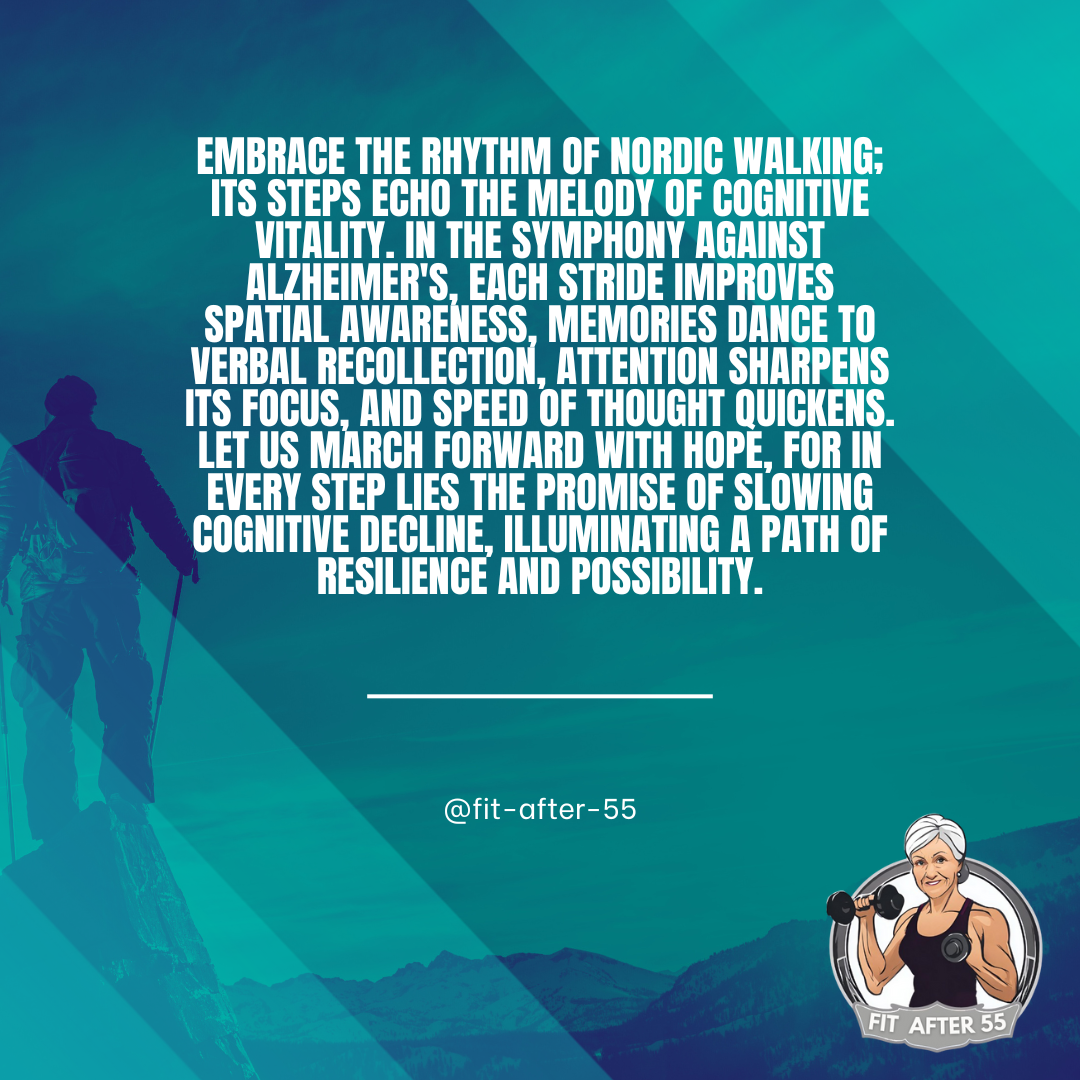
The Science of Nordic Walking
Nordic walking is a form of physical activity that combines walking with the use of specially designed poles. This technique enhances your natural walking experience, providing a comprehensive workout scientifically demonstrated to offer biomechanical and psychological advantages.
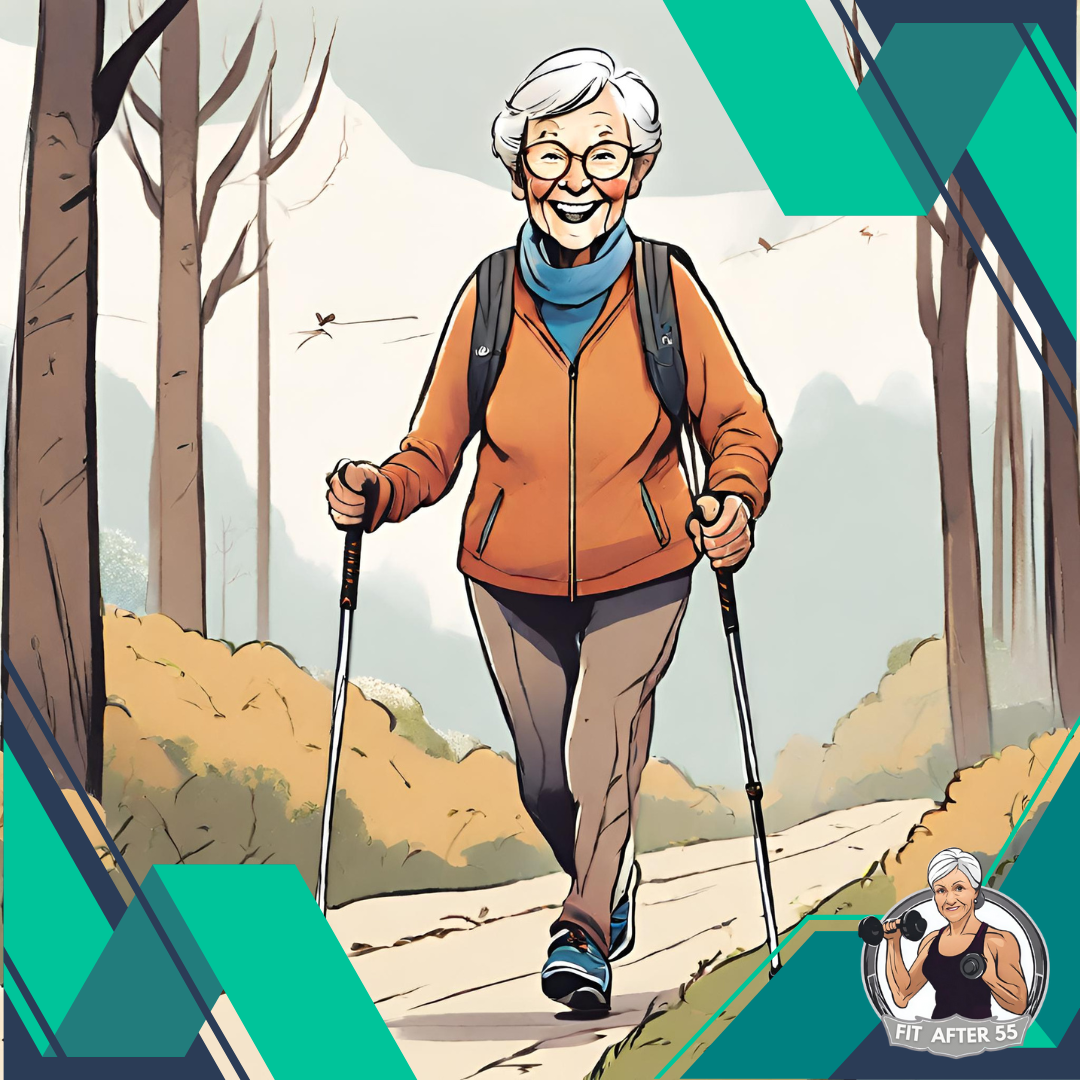
Biomechanics of Nordic Walking
Nordic walking transforms standard walking into a full-body exercise by incorporating the use of poles. This activity results in:
- Enhanced calorie expenditure compared to standard walking
- Improved cardiovascular workout attributed to the involvement of upper body muscles, without placing excessing stress on joints
- Potential for increased aerobic capacity, as supported by a study noting that Nordic walking can be more effective than traditional walking in improving your cardiopulmonary functions
Psychological Benefits of Exercise
Regular physical activity, including Nordic walking, positively affects your mental well-being. The involvement of rhythmic, aerobic exercise can:
- Lead to decreased symptoms of depression and anxiety
- Positively influence sleep quality and energy levels
- Contribute to overall mood improvement by releasing endorphins, the body’s natural feel-good hormones
Nordic Walking and Stress Reduction
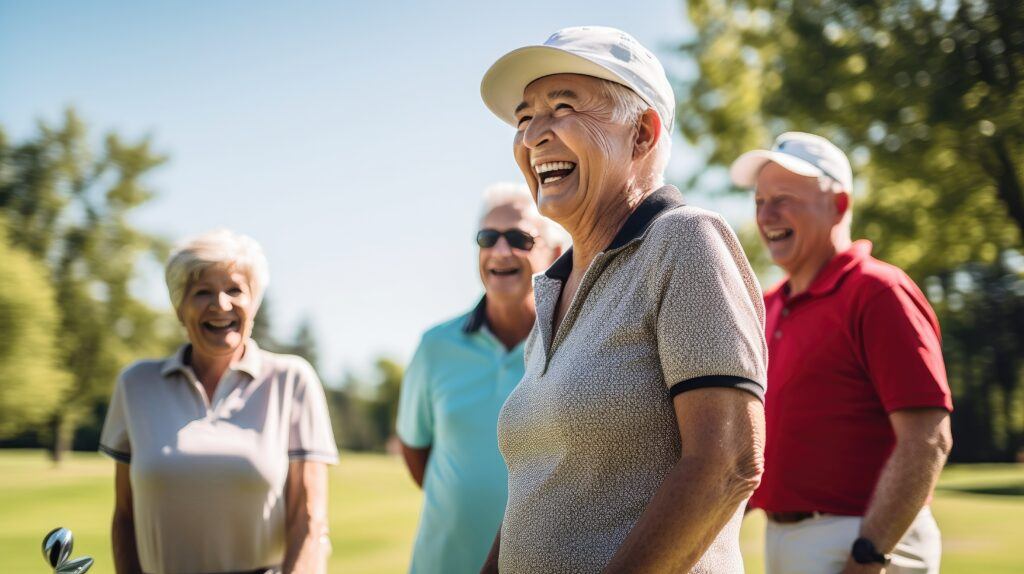
Nordic walking is a physical activity that enhances physical fitness and has been identified as a potent stress reliever. This section will delve into the mechanisms behind its effectiveness in reducing stress and compare it with other walking styles.
Mechanisms of Stress Relief
Nordic walking engages your upper body through the use of specifically designed poles, which, unlike regular walking, provides a full-body workout. This activity increases the production of endorphins, the body’s natural mood lifters, helping to alleviate stress. The rhythmic motion and increased intensity associated with Nordic walking can also mediate stress by promoting a meditative state, allowing for a mental break from stressors.
- Physical Mechanisms: Increases endorphin production and involves rhythmic motion.
- Psychological Mechanisms: Facilitates a meditative state and provides mental distraction.
Comparative Studies on Walking Styles
Studies assessing the impact of different walking styles on mental health suggest that Nordic walking can be more beneficial than general walking for stress reduction. One key factor is that Nordic walking typically burns more calories and can lead to more significant improvements in physical health, which, in turn, positively influences mental well-being. Additionally, the focus required for Nordic walking can help redirect thoughts away from stress-inducing topics.
- Calorie Expenditure: Higher in Nordic walking, contributing to better stress management.
- Mental Engagement: Technique-focused walking style provides a helpful distraction.
Nordic Walking and Anxiety Management
When you engage in Nordic walking, it can have a significant effect on your anxiety levels. This low-impact aerobic exercise positively influences your mental health by reducing anxiety symptoms.
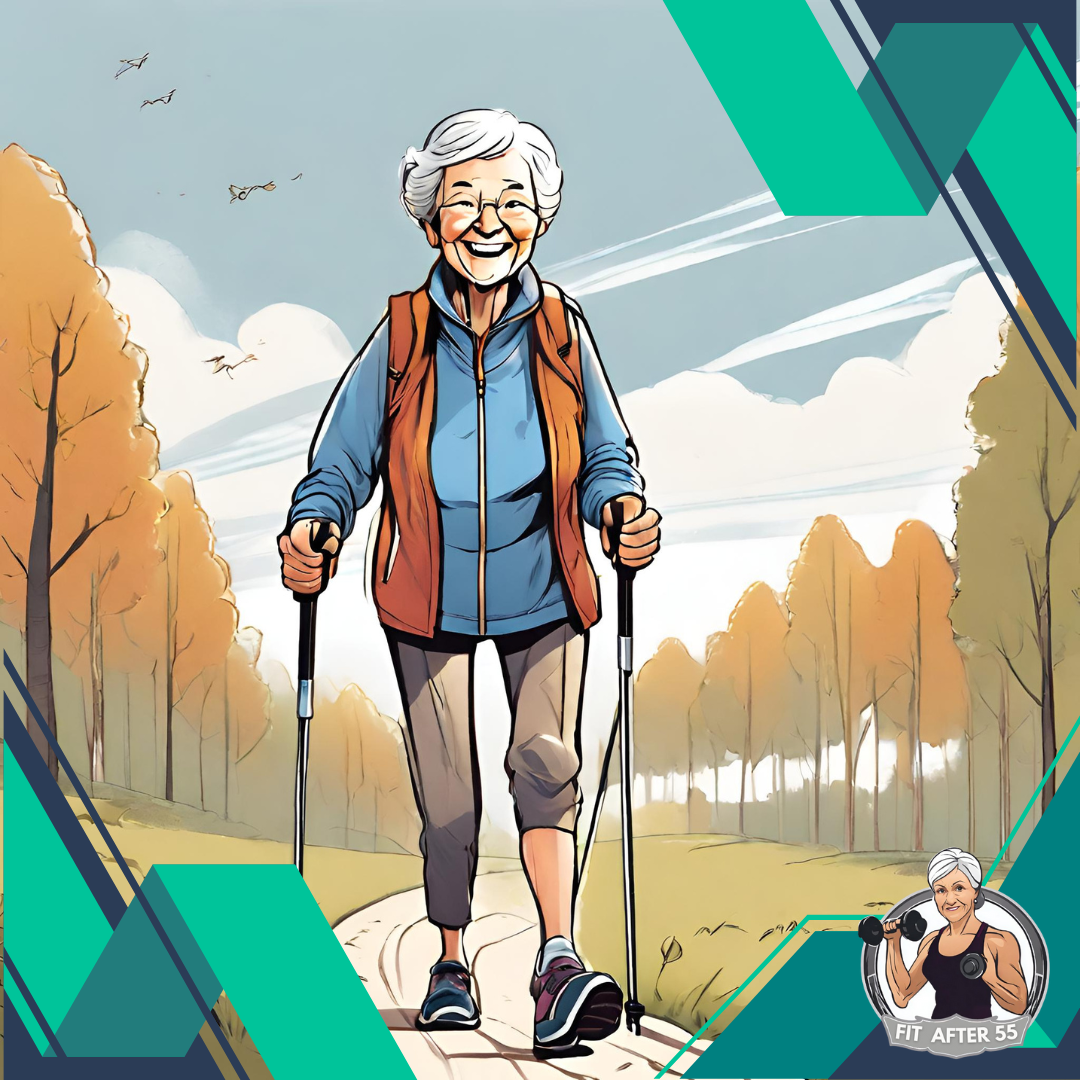
Physiological Impact on Anxiety
Hormones: Nordic walking elevates your heart rate and stimulates the production of endorphins, which are chemicals in the brain that act as natural painkillers and mood elevators. Studies, such as Climbing as an Add-On Treatment Option for Patients with Severe Anxiety, indicate that aerobic exercise like Nordic walking can reduce stress hormones in the body, such as adrenaline and cortisol, contributing to a calmer state of mind.
Breathing: The rhythmic breathing required during Nordic walking helps regulate your nervous system, enticing a relaxation response that can be particularly beneficial for anxiety management.
Physical Health Improvements:
- Cardiovascular fitness: Improved heart health can result in overall well-being.
- Muscle strength: Reduced physical tension can lead to decreased mental tension.
- Joint health and mobility: Promotes joint mobility and flexibility, especially in older adults
Mindfulness and Nordic Walking
Awareness: Nordic walking requires you to focus on your movements and the surrounding environment, promoting present-moment awareness—a key component of mindfulness that can break cycles of anxious thoughts.
Connection: By walking in natural settings, a systematic review and meta-analysis have shown that engaging with nature can enhance your mood and further the benefits of mindfulness practice.
- Sensory engagement: Attention to the sights, sounds, and smells around you can reinforce mindfulness.
- Regular practice: Consistency leads to more effective anxiety management.
Implementing Nordic Walking into Daily Routine

To effectively integrate Nordic walking into your daily life, setting achievable goals and incorporating mindfulness techniques is crucial. This approach will enhance the physical and mental health benefits of your walks.
Setting Realistic Goals
- Start Small: Start with manageable distances that align with your fitness level. A study recommends starting with short, frequent walks to gradually build up your endurance.
- Consistency Over Intensity: Aim to walk several times a week rather than opting for less frequent, intense sessions. This helps establish a routine and makes Nordic walking easier to become a habit.
- Progress Gradually: Increase the duration and intensity of your walks over time. This will help improve your physical fitness without overwhelming you or causing injury.
Incorporating Mindfulness Practices
- Conscious Breathing: Focus on your breath while walking to help center your mind, which can reduce stress and anxiety.
- Sensory Awareness: Pay attention to the sights, sounds, and sensations around you, engaging all your senses to stay present and immersed in the experience.
- Reflective Pauses: Take moments during your walk to stop, reflect, and appreciate your environment. This practice can deepen the mental health benefits by cultivating gratitude and presence.
Nordic Walking Technique and Gear
To harness the full potential of Nordic Walking for mental health, it’s imperative to master the proper pole techniques and invest in the appropriate gear.
Proper Pole Technique
Grip: You must hold the poles lightly, allowing your wrists to flex naturally. Arm movement should be in harmony with your opposite legs, swinging smoothly as you walk.
Pole Angle: Place poles at about a 45-degree angle to the ground, ensuring they are slightly behind your body as you move forward.
Choosing the Right Equipment
Poles: Select poles that match your height; they should reach your armpits when standing on end. Look for options with comfortable strap systems, such as the Nordic Walking Poles from 100% Norway, to secure your hands and reduce strain.
Footwear: Choose supportive shoes that cushion and protect your feet, offering good traction for various terrains.
Community and Social Aspects
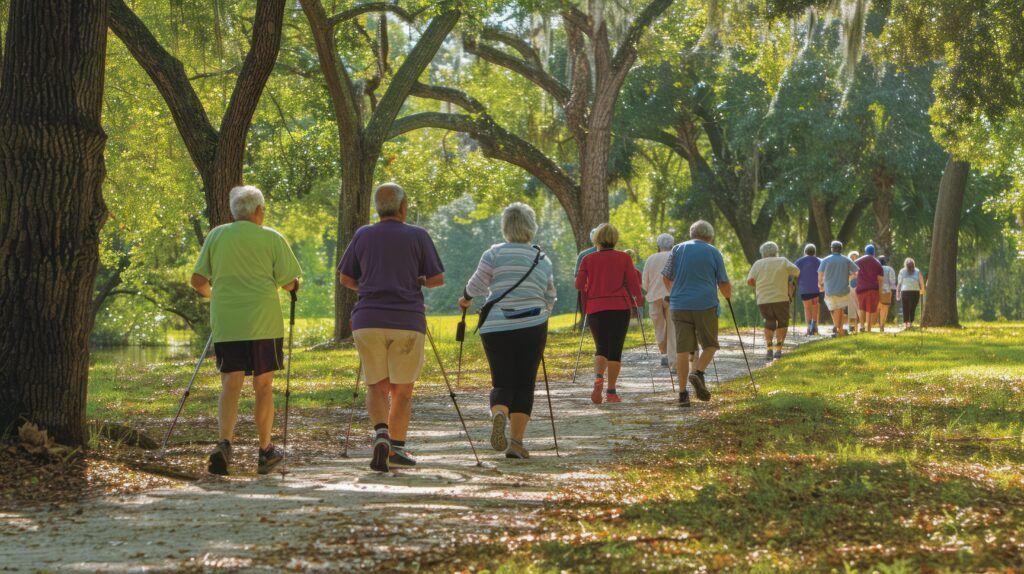
Nordic walking promotes physical health and bolsters mental well-being through its community-driven and social aspects. Joining a Nordic walking group can significantly reduce stress and anxiety.
Group Walking Benefits
Participating in group walking activities, especially for older adults, the shared experience can increase motivation and commitment to regular exercise. Research has highlighted that Nordic walking is a social activity encouraging community members, including instructors and practitioners, to communicate and share values such as health and fitness benefits. By engaging in this activity together, you are likely to form social bonds within groups, which reinforces a sense of belonging and contributes to your emotional well-being.
Social Support Networks
Engaging in Nordic walking allows you to build robust social support networks. These networks provide emotional backing and practical assistance, which are crucial for mental health. A strong support network might give you a sense of being valued, cared for, and understood—all of which can have a profound impact on combating feelings of stress and anxiety. With Nordic walking, these networks often extend beyond the walk, as many participants report forming lasting friendships with their walking peers.
Challenges and Considerations
Integrating Nordic walking for mental health can be transformative, yet you may encounter hurdles that require strategic planning and adjustments.
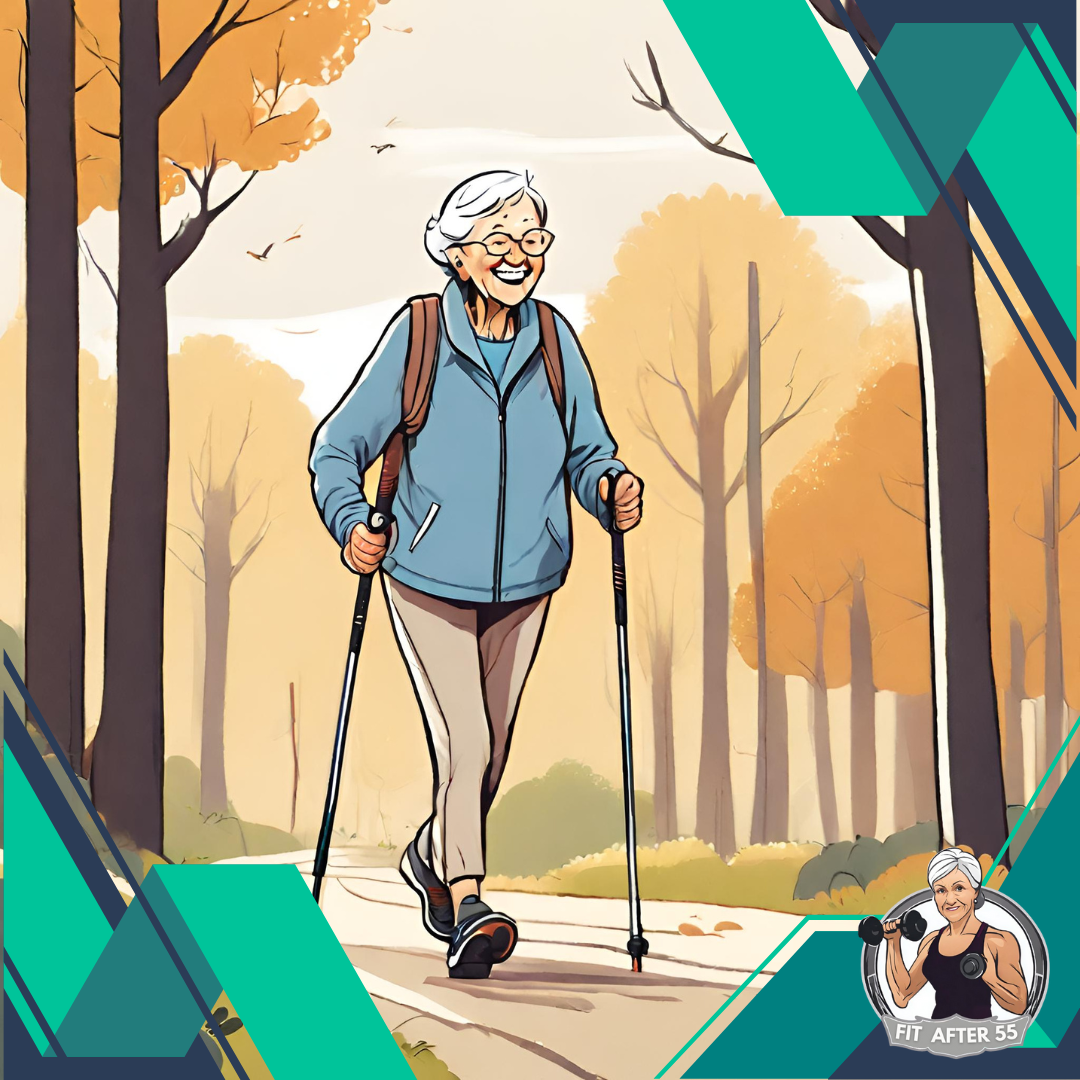
Overcoming Common Barriers
Accessibility: You need access to suitable walking poles and an appropriate environment. Urban settings may lack the natural landscapes that enhance the therapeutic effects of Nordic walking.
Motivation: Initially, you might find it challenging to maintain regular walking sessions. Establishing a routine is vital; pairing up with a walking buddy or joining a group can help sustain motivation.
Adapting Nordic Walking to Various Populations
Age Differences: Tailor the intensity and duration of Nordic walking sessions to match the physical capabilities of different age groups. Elderly individuals may benefit from shorter, more gentle walks, while younger adults might engage in more vigorous sessions.
Physical Limitations: Modify the Nordic walking technique for those with physical disabilities or injuries. This may include adjusting the walking poles for grip and height or selecting flat, even terrains for easy walking.
Measuring Progress and Mental Health Outcomes

To effectively manage Nordic walking for mental health, it’s essential to track your progress meticulously and observe changes in your mental well-being.
Tracking Walking Statistics
You can utilize various tools to monitor your walking statistics, such as pedometers, smartphone apps, or GPS watches. Record the distance you walk, the time you spend, and the intensity level of your Nordic walks. Consistent logging lets you see your physical activity trends over time and make data-driven adjustments to your routine.
Assessing Mental Health Changes
Assessing the impact of Nordic walking for mental health entails regular self-reflection and may also benefit from structured psychological evaluation.
You can track changes in your mood and stress levels before and after walking sessions using diaries or mood scales.
Additionally, completing standardized questionnaires can provide a more objective view of your mental health trajectory.
Resources and Further Reading
When seeking to understand the impact of Nordic walking for mental health, there are numerous scholarly articles and research papers that you can reference. Here’s a curated list of resources that dive into the various aspects of Nordic walking and its role in reducing stress and anxiety:
- Clinical Studies: For insights on therapeutic effects, the clinical pilot trial titled [“A Comparison of Acute Effects of Climbing Therapy with Nordic Walking for Inpatient Adults with Mental Health Disorder”] (https://www.ncbi.nlm.nih.gov/pmc/articles/PMC9180369/) provides data on how Nordic walking could influence affective responses and self-efficacy.
- Systematic Reviews: To grasp the broader impact of walking in nature, check out the meta-analysis “Effect of Nature Walks on Depression and Anxiety: A Systematic Review,” which examines a range of studies assessing the mental health benefits of nature walks.
- Research on Walking and Emotional Health: For a focused look at walking’s correlation with emotional well-being, the article “Exploring the Relationship between Walking and Emotional Health in…” discusses the positive influence of walking environments on mental health.
- Practical Insights: The website Lets Walk Nordic offers a practical viewpoint with firsthand accounts in “Mental health and Nordic walking”, including survey results connecting Nordic walking with improved mental well-being.
- COVID-19 Related Research: Given the recent challenges posed by the pandemic, the article “A Systematic Review and Meta-Analysis of Nature Walk as an Intervention…” provides perspective on nature walks as a potential community-level protective factor against mental health issues.
Step into Wellness with Nordic Walking for Mental Health
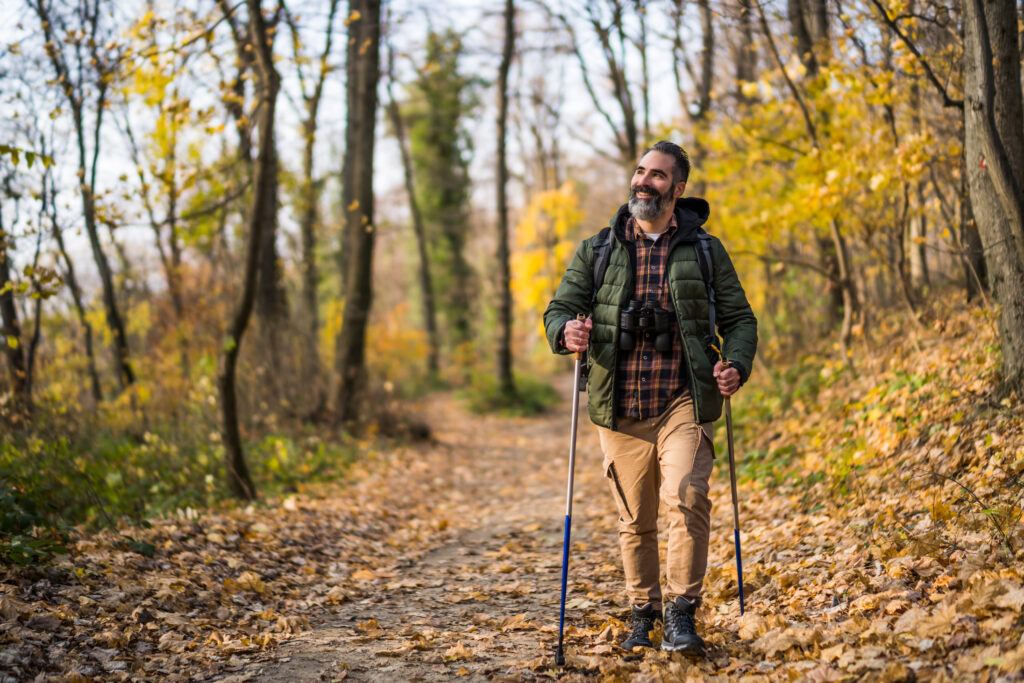
Nordic walking for mental health offers not just a physical workout but also a mental health boost, making it a perfect choice for anyone seeking overall well-being. Engaging in Nordic Walking not only strengthens your body but also calms your mind, providing a holistic approach to wellness.
Whether in your golden years or just starting your fitness journey, Nordic Walking can be a gentle yet effective way to stay active and connected. So why not grab your poles, step outside, and embark on a journey towards a healthier, happier you? Let Nordic Walking be your path to wellness.
Frequently Asked Questions
Nordic walking is recognized for its mental health benefits, especially in reducing stress and anxiety. This section addresses some common queries regarding the practice.
How does the rhythm of Nordic walking contribute to mental health improvement?
The rhythmic motion of Nordic walking promotes a meditative state, which helps to alleviate stress and improve mental well-being.
This repetitive movement can be soothing and help regulate your breathing.
Are there specific Nordic walking techniques recommended for stress reduction?
For stress reduction, a technique focusing on deep breathing and mindful movements is beneficial.
Paying close attention to your stride and breathing can create a calming effect on the mind.
Can regular Nordic walking be a part of a therapeutic routine for anxiety disorders?
Yes, regular Nordic walking can be integrated into a therapeutic routine for anxiety. It is shown to positively affect affective responses and can be used alongside other treatments under professional guidance.
How long should a Nordic walking session last to effectively alleviate stress?
A session of about 30 minutes to one hour can be effective in lowering stress levels.
However, even shorter durations have mental health benefits, with regular consistency being key.
What are the psychological benefits of engaging in outdoor Nordic walking?
Outdoor Nordic walking can increase mood-enhancing endorphins, lower symptoms of depression, and reduce anxiety, offering an overall boost to psychological well-being.
In what ways can Nordic walking be combined with mindfulness practices to combat anxiety?
Combining Nordic walking with mindfulness involves focusing on the present moment. It also consists of observing the sensations in your body, the environment, and the movement of your poles. This connection can enhance the anxiety-reducing effects of both practices.
Discover the Secret to Thriving After 55
At Fit After 55, we’re dedicated to empowering older adults on their wellness journey. This is your ultimate destination to dive into a treasure trove of resources, from expert tips on staying active and healthy to inspiring stories from individuals like you who have embraced the power of fitness after 55. Don’t let age define you – visit Fit After 55 today and enjoy life to the fullest!

